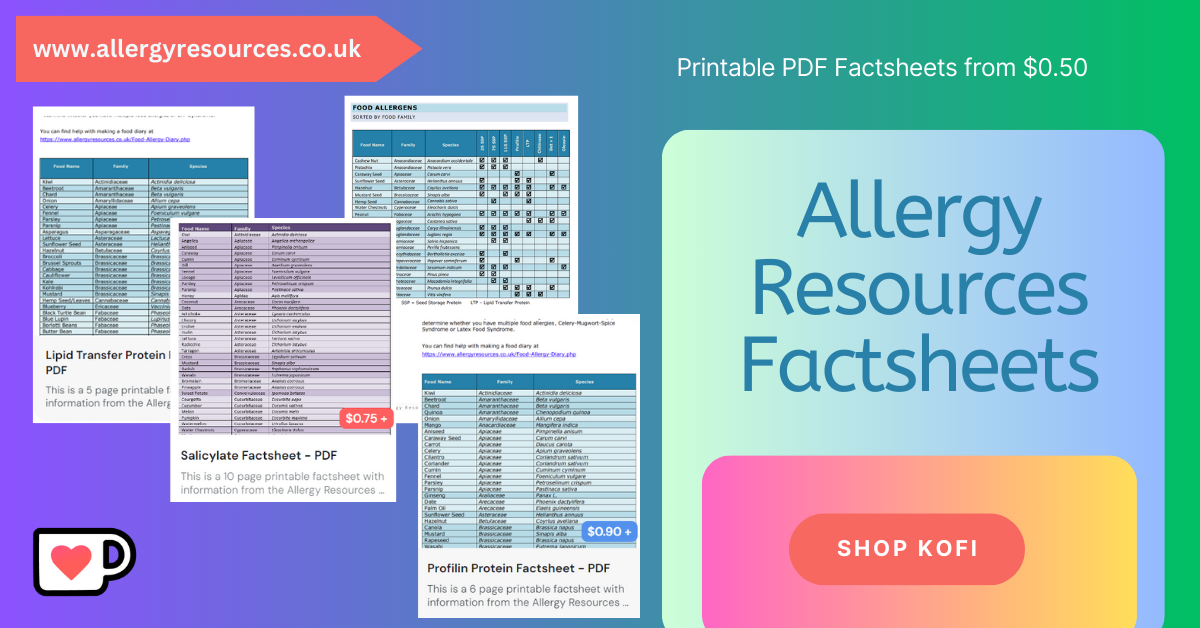
ORAL ALLERGY SYNDROME
Allergic Syndrome
This syndrome is now more commonly called Pollen Food Allergy Syndrome (PFAS) - the term "Oral Allergy" has been adopted to define the symptoms of the syndrome. The Pollen Food Allergy page has more detailed information on why this happens.
Sufferers of Oral Allergy are usually people who already suffer from pollen allergies and seasonal rhinitis and this is due to cross reactivity.
The symptoms of oral allergy syndrome are itchy or swollen lips, gums, tongue and throat. The symptoms should go away with anti histamine. It is usually caused by raw fruit, vegetables, herbs, spices and nuts. If you can eat these foods cooked then you are most likely suffering from Pollen Food Allergy Syndrome as the protein which causes them are denatured by heat.
Sufferers of Oral Allergy are usually people who already suffer from pollen allergies and seasonal rhinitis and this is due to cross reactivity.
The symptoms of oral allergy syndrome are itchy or swollen lips, gums, tongue and throat. The symptoms should go away with anti histamine. It is usually caused by raw fruit, vegetables, herbs, spices and nuts. If you can eat these foods cooked then you are most likely suffering from Pollen Food Allergy Syndrome as the protein which causes them are denatured by heat.
Key Allergens
The allergens associated with oral allergy are initially a tree or plant pollen and associated with those pollens are various fruits, herbs and vegetables.
Pollens usually associated with Oral Allergy symptoms are alder, birch, grass, mugwort and ragweed pollens.
Pollens usually associated with Oral Allergy symptoms are alder, birch, grass, mugwort and ragweed pollens.
Cross Reactivity
If sensitised to alder pollen you may also react to apple, cherry, peach, pear, parsley, celery, almonds, and hazelnuts.
If sensitised to birch pollen you may also react to apple, kiwi, pear, peach, plum, nectarine, apricots, cherries, tomato, celery, carrot, potato, parsnip, pepper, dill, cumin, peas, coriander, fennel, hazelnut, walnut, almonds, peanuts, lentils and beans.
If sensitised to grass pollen you may also react to melon, watermelon, tomatoes, oranges, potatoes and peanuts.
If sensited to mugwort pollen you may also react to, apple, celery, carrots, dill, parsley, fennel, coriander, cumin, and sunflower seeds.
If sensitised to ragweed pollen you may also react to watermelon, banana, courgette, cucumber and squash.
If sensitised to birch pollen you may also react to apple, kiwi, pear, peach, plum, nectarine, apricots, cherries, tomato, celery, carrot, potato, parsnip, pepper, dill, cumin, peas, coriander, fennel, hazelnut, walnut, almonds, peanuts, lentils and beans.
If sensitised to grass pollen you may also react to melon, watermelon, tomatoes, oranges, potatoes and peanuts.
If sensited to mugwort pollen you may also react to, apple, celery, carrots, dill, parsley, fennel, coriander, cumin, and sunflower seeds.
If sensitised to ragweed pollen you may also react to watermelon, banana, courgette, cucumber and squash.
Resources
Websites
Allergy UK - Types of Food Allergy
AAAAI - Oral Allergy Syndrome (OAS)
FARE - Related Medical Conditions
Patient UK (NHS) - Oral Allergy Syndrome
Articles and Journals
Diagnosis and Management of Pollen Food Allergy Syndrome to Nuts, 2024
Comprehensive Study on Key Pollen Allergens, 2022
Oral Allergy Syndrome: An Anaphylactic Reaction Overlooked, 2021
Pollen-related food allergy in children with seasonal allergic rhinitis, 2021
Can patients with oral allergy syndrome be at risk of anaphylaxis? 2020
Molecular approach to a patient’s tailored diagnosis of the oral allergy syndrome, 2020
Food cross-reactivity in patients with pollen allergies, 2020
Update on pollen-food allergy syndrome, 2020
Let me know if you found any of these interesting or useful.
If you spot an article or research that you think is interesting you can message me or tag me on Facebook or Twitter - links at the bottom of the page.